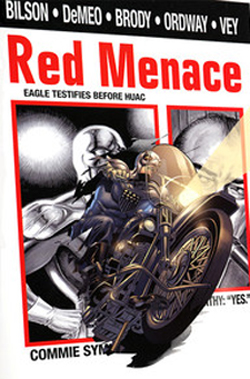 The collected Red Menace revisits the early 1950s, the heyday of Joe McCarthy and HUAC, when America was paranoid about commie plots and demagogues like McCarthy destroyed lives without much regard for facts. One target was L.A.’s own caped crusader, the Eagle, who happened to be a war hero named Steve Tremaine.
The collected Red Menace revisits the early 1950s, the heyday of Joe McCarthy and HUAC, when America was paranoid about commie plots and demagogues like McCarthy destroyed lives without much regard for facts. One target was L.A.’s own caped crusader, the Eagle, who happened to be a war hero named Steve Tremaine.
Shattered when he learns of the death of his friend, Soviet crimefighter Ivan Petrovich, known as the Bear and the pretext for McCarthy’s smear, and further demoralized by the loss of his reputation as a patriot, Tremaine sinks into despair. However, a young man named Tommy Woods, who has telekinetic powers that he can’t quite control, wants the Eagle to train him.
There is a plot to take over America, but it’s not by the communists, and the man behind it has his own ideas about who should lead the new order.
Stripped of time, place and characters, the story is basically sound. The climax could even have taken on a truly tragic cast. With the milieu, if this series had been published in the late 1950s or ’60s, it would at least have a historical sense to it and might be taken as social commentary, because it’s not really much of an adventure story. It was published in 2007, and I find myself wondering “Why the context of one of the most notorious demagogues in American history?” There doesn’t seem to be any sort of real social commentary, no investigation, even by inference, on the role of demagoguery in American political discourse today. Although I’m not necessarily going to expect social relevance from superhero comics — although there has been a strong trend in that direction for at least a decade, and probably much more — it’s hard to deal with a set-up like this one that delivers no payoff.
There’s not much in the way of psychological resonance here, either. (And that’s another thing I think we have a right to expect in this post-Dark Knight world.) What passes for psychology is all on the surface, and not very complex at that. McCarthy and company are suitably slimy — and how could they be otherwise — but it’s a matter of stereotyping more than any real examination of motives. (And can someone explain why, in this day and age, the writers thought it was a viable device to have the gay man as the real villain? No one’s done that for twenty years or better, except maybe as parody.) The good guys don’t fare much better. There are parts of the story that could have set up some resonance, but they’re not very persuasive — too many of them, like the death of the Bear, are throwaways.
The art, penciled by Jerry Ordway and inked by Al Vey, is perfectly in keeping with the story. It’s highly finished but not overdone, and there is a certain sense of claustrophobia that reinforces the mood of much of the narrative. The art actually helps to ameliorate some of the lacks in the script.
I’m afraid my reaction to Red Menace boils down to one central problem: I didn’t believe a word of it, and even in a superhero comic, something should be believable.
(Wildstorm Productions, 2007)
